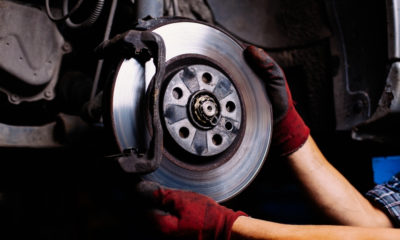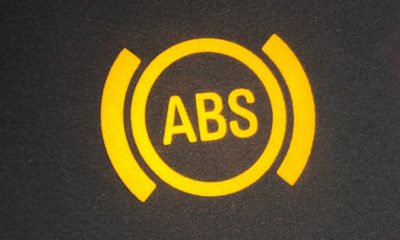Automotive
How to Get the Best Deal on a New Car
Purchasing a new, or pre-owned car, truck, or SUV is something most Americans do every 6-7 years on average. When your turn comes, how do you know if you actually got a great deal?
Published
3 years agoon
By
Ryan Adrian
Last updated on August 15th, 2021
Purchasing a new, or pre-owned car, truck, or SUV is something most Americans do every 6-7 years on average. When your turn comes, you’ll work with sales professionals that sell cars everyday, and are quite adept at the process. A salesperson that is good at their job will leave you feeling good about your purchase. How do you know if you actually got a great deal?
There are some key differences between purchasing new vs. used. For the purposes of this guide, we’re focusing on new vehicles.
Time of Year
Timing is everything. If you can help it, there are certain times of the year where manufacturers offer more aggressive incentives than others. This greatly helps your ability to purchase a new vehicle for a great price.
Frankly, this summer is one of the historically worst times to buy a car due to inventory shortages, and unless you are in dire need, put off your purchase for a few months. If you are able to downsize your personal fleet due to remote work, trade values are at record highs.
The general rule of thumb for the best time of year depends on the manufacturer’s model year cycle. Generally, many auto makers have large model year end sales that start in August. Typically, they will offer rebates, 0% APR, and improved lease rates for the outgoing model year.
Model year end varies from manufacturer to manufacturer. It often varies within each manufacturer, too. For example, Toyota has certain models that are released in the spring, and others that are later in the year. If you’re starting the process of looking for a vehicle, ask, “when does the new model year come out?”
If you are happy with the current model year, and aren’t actually holding out for new styling available in the yet to be released model, you can be sure the auto maker will be offering some heavy incentives a month or two before that new model year arrives, and also for a few months afterward to ensure all of the inventory is cleared out. Individual dealers will also be more aggressive to sell “old” units because they don’t want to be stuck with them.
Another popular time of year where manufacturers have historically had excellent incentives is in December for year end sales. Most auto makers have some kind of holiday or year end event to make a push for year end numbers. Though it isn’t recommended to put a bow on a new Lexus and surprise your spouse with it in the driveway as the commercials would lead you to believe, it is still generally a great time to buy because incentives are generally in line with the most aggressive ones they offer at any other point in the year.
Do Your Research
Everything is online. Dealers know this, too. Sites like Cargurus and Truecar provide you with market pricing data, and new vehicle invoices are easily available, too. Be confident in the vehicle you want to purchase. Research details about it – which trim level, options, and other aspects of it you want. See what others are paying for it. Look at the manufacturer’s website to see what the current incentives are in your area. Get an opportunity to sit in one, and test drive it. Some options are at a dealership, or as a rental, or if you know someone that owns that model.
During this research phase, if you are test driving for the sake of wanting to know if you fit properly in the vehicle, and it can do everything you want, keep your dealership visit to that alone, and don’t commit to purchasing, yet. You can work on getting a quote with that dealership, but do not commit, yet.
Aside from price, also be sure to research other aspects of the transaction, as well. If you plan on trading a vehicle in, be sure to get a trade estimate ahead of time. One great resource for this is the Kelley Blue Book Instant Cash Offer. Be honest with the condition of your vehicle, and you will not only get an estimate, but you will be able to work with a few dealerships to purchase your vehicle for that amount, assuming the inspection matches the description you provided. This opens up your options to having a couple dealers to compete for your vehicle, helping you get more for it.
Financing is another part of the transaction that most new car buyers must consider, too. Check the manufacturer’s site for any incentives related to APR, as well as your bank, or local credit unions. Generally, the manufacturer’s financing arm will have the best rate, especially if there’s an incentive available.
If there aren’t any APR specials available from the manufacturer, credit unions tend to be the next best option. Keep these rates in mind based on what you estimate your credit score to be, so that you can see what rates the dealership is able to find at the time when you are purchasing. If you don’t know your credit score, use a free tool like Credit Karma to get an idea of what your score is. Keep in mind that the scores you see on your end with free tools tend to not match exactly what the official bureau report would show, but is generally pretty close.
One other aspect that should be considered ahead of time, but is often overlooked by car buyers is warranty coverage, and other protection packages. Dealerships make a lot of their money by selling GAP plans, vehicle service agreements, tire and wheel protection, paint and fabric protection, and other add-ons through the finance office.
Some manufacturers include GAP coverage in their leases automatically, and that’s a good thing. Others sell it as an add-on. If your lease doesn’t have GAP coverage included automatically, another option is to add it to your car insurance coverage. It’s easily possible that if you would actually need to use the GAP coverage because your vehicle was totaled, the additional premium plus your deductible would still come out to cost less than what the dealership would try to sell you that plan for.
Vehicle service agreements can be a good thing. If a dealership is selling a third-party, or aftermarket vehicle service agreement (one that isn’t affiliated directly with the manufacturer), it can also be a terrible waste of money. These plans can be sold for several thousands of dollars, but are also written in a way to limit how much it can actually be used. If your vehicle experiences a catastrophic failure, the vehicle service agreement could end up saving you a great deal of money. Service agreements typically do not cover wearable items, such as tires, brakes, wiper blades, and basically the most common things that need to be replaced on a vehicle.
If you are considering any of the add-on products, be sure to research those options available with the manufacturer ahead of time. If the dealership offers you something that isn’t branded with the manufacturer’s information all over it, use extreme caution. The manufacturer’s plans tend to be the best ones available because of the coverage they offer, plus they are compatible with any franchised dealer in the United States, and not just that one individual dealership.
Shop Around
There should be at least 2-3 dealerships within driving distance that would be willing to compete for your business. You don’t have to visit all 3. Dealership websites have come a long way in the last few years, and many have adopted digital retailing tools, where you can work payments directly on their site with vehicles they have available.
If your local competitive dealers did not adopt this technology yet, simply fill out a form requesting a quote on a comparable model they have in stock, and mention that you already have a competitive quote from the dealer you test drove with (if applicable).
If the second and/or third dealership asks you about the price quote you received, give them all the details you have, except the actual price quote. Let them give you a number first so that they don’t have a preconceived idea of just beating what the first dealer gave you by $100, or some arbitrarily smaller discount than they otherwise would do.
It is fair to make sure everyone has apples-to-apples comparisons so that there isn’t the argument of, “my price is higher because this vehicle has more features…” or something along those lines. Again, salespeople are adept at overcoming objections, and they will be quick to turn to their greatest hits to justify a higher selling price. Everything that you can counter back with that negates their arguments strengthens your position.
Ultimately, what you are looking for from any of these dealerships that you are getting quotes from is a compelling reason to leave your house and spend time at the dealership to complete the transaction.
You can get much of the legwork done ahead of time, so that by the time you get to the store to complete your transaction, you will not have of the back-and-forth, “let me go ask the manager…” and, “If I could do X would you buy it then?” types of conversations that tend to extend a visit by several hours.
“No” Is Your Best Friend
At whatever point you are negotiating, do not be afraid to say, “no.” Most dealerships do not give you their best price upfront, and are willing to go more aggressive when needed to complete the sale. If you’re able to get through this phase outside of the dealership, it will be much better, as this can lead to extended time in the dealership for negotiations.
Have reasonable expectations. A vehicle that has an MSRP of $30,000 cannot be discounted to $20,000. It can’t even be discounted to $25,000, unless there are substantial rebates from the manufacturer. Know what you are comfortable with, and do not accept the first offer they present you. You know what you are comfortable with, and stick to it. Don’t be afraid to walk away, if needed. Assuming you’re not in dire need of a car immediately, you can walk out of the dealership without an agreement. By all means, still talk to them by phone to see if they can do better. Oftentimes, a sales manager will directly intervene before you actually leave to try to convince you to stay and complete the sale. This typically would lead to being their best offer they can provide you.
Be Sure They Show the Math
Many dealerships have what are known as desking tools. That is a program that takes whatever parameters the sales manager provided, and it prints out a nice, neat looking proposal sheet with different purchase or payment options. The purpose of it is to generate an easy to read proposal that anyone can understand. The downside is it often leaves out a lot of information that is important for you to know. Are you able to see the actual selling price? How about the interest rate? Are any other fees mentioned, and how much are they? Make sure everything that goes into the payment is fully transparent.
Some common tactics that some dealers use are to “pack” certain products into the selling price of the vehicle. Such examples include a vehicle service agreement, or GAP plan. Another common tactic is they will mark up the finance rate. They do this to make up profit for the discounted price they are showing you. Ask for transparency into what is being used to calculate everything so that there aren’t any hidden surprises.
A visual analogy that can be used in this process is an inflated long balloon. If you hold it out horizontally, it’s uniform in size the entire length. Once you pinch a certain part of it, other areas of the balloon inflate more to make up for it. Think of negotiating with a dealership as being similar to this. If you focus on only one thing, such as the price, they will find other areas to inflate to make up for it. The most common ways are with a trade, if you have one, or with financing.
Remain Calm and Positive
A transaction that involves tens of thousands of your hard-earned money gets emotional. Many people let those emotions get the best of them and throw epic temper tantrums if they don’t get what they want out of the dealership. Everyone involved in the process is human, and even if a mistake happened, don’t let the temper fly.
Think of it this way – which would you be more willing to work with? Would you want to work with someone that is berating you with obscenities? How about screaming because they don’t like the conversation? It’s likely you’d say, “hard pass,” to that. Maintain a straightforward, calm, and reasonable conversation. People are more willing to work with you if you work with them.
Read Your Paperwork Before Signing
This step is crucial. Make sure nothing is lost in translation between the sales desk and the finance office. Things can happen where not everything translates 100%. If you are expecting to get 0% financing, make sure it’s on there, and through the correct bank. Make sure all the numbers match up to what you agreed to. The selling price, trade value (if applicable), any rebates should all clearly appear as discussed. It is incredibly easy to just blow through the paperwork just because you’ve already had a time consuming process. You’ve made it this far, be sure to read what you are committing to. You are agreeing to parting with tens of thousands of dollars. Taking a few extra minutes to make sure everything is in order is not unreasonable.
Related FAQ
From the beginning of the process, people typically spend about 14 hours researching their vehicle purchase. From there, an additional couple of hours are typically spent contacting dealerships, and qualifying which one to visit. The actual time spent at the dealership can range from a half hour to a full day, depending on how much of the process is completed ahead of time, and no unexpected surprises happen. The overall average amount of time spent at a dealership purchasing a car is 3.6 hours.
Technically speaking, yes. There are many complications that would arise, especially if you are planning on financing your purchase. In order to get a lease or loan, finance companies require insurance, which requires a valid driver’s license. Also, in order to register the vehicle, you need a valid driver’s license, so you would have to have a second person with a license on the title in order to make it legal to be on the road.
So long as your credit limit is high enough, yes. The dealership may try to balk at the idea because of the transaction fee that comes out on their end, but typically they are bound to agreements with credit card processors that they must accept credit cards for any transaction.
This depends on requirements in your state. Some states have strict laws requiring all drivers to be insured. Others do not require insurance at all. The other stipulation would arise when you lease or finance your purchase. All finance companies require full coverage while the vehicle is financed so that they don’t lose thousands of dollars in the event the vehicle is declared a total loss after an accident.
You may like

How to Plan for Retirement

What happens when you refinance a car?

What Is the Best Cryptocurrency to Invest in 2021?

What are the easiest ways to invest in the stock market?

How to Create a Personal Budget













